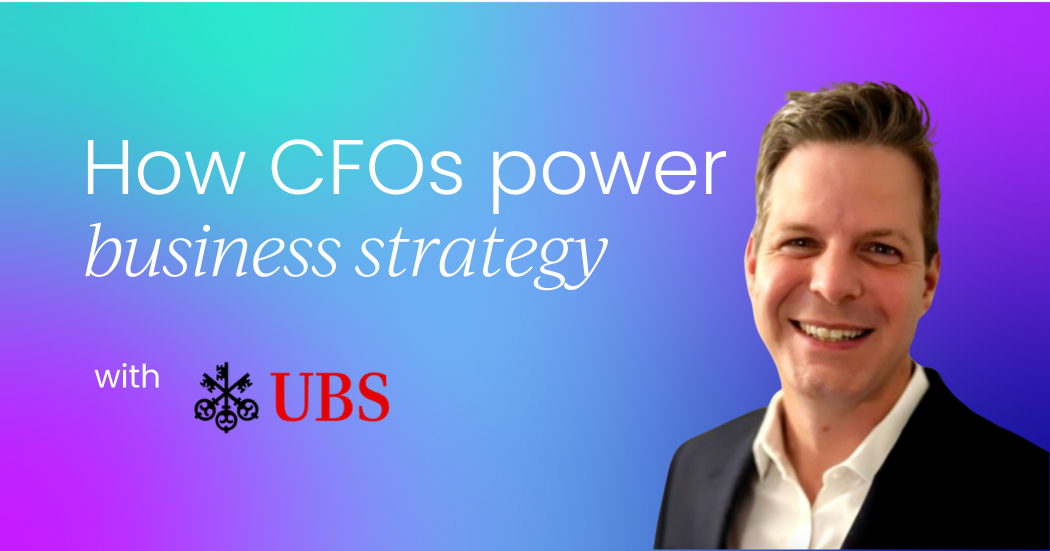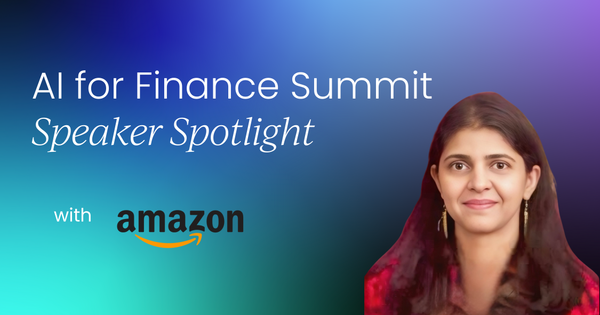The AI for Finance Summit 2025 is just around the corner, and we’re thrilled to spotlight one of our incredible speakers: Tripti Nashier, Finance Manager at Amazon. Known for building smart, scalable forecasting models and championing innovation within one of the world’s most complex finance organizations, Tripti brings a pragmatic yet forward-thinking lens to AI in finance.
In her upcoming panel discussion, 'Overcoming AI adoption barriers in finance: Practical steps for implementation', Tripti will dive into a challenge many finance teams face: getting AI out of the pilot phase and into full production. It's not just about choosing the right tools - it's about navigating internal blockers, aligning stakeholders, and laying the operational groundwork to make AI truly work.
We sat down with Tripti to talk about her upcoming talk at the AI for Finance Summit and her previous talk at the FP&A Summit.
So, let’s jump into our conversation.
Can you tell us about yourself and your role at Amazon?
I'm Dr. Tripti Nashier, a Finance Manager at Amazon, where I lead design and implementation of advanced financial planning solutions that integrate operational data, forecasting, and cost attribution across business functions.
My work spans novel solutions in financial forecasting, revenue management, workforce optimization, and fulfillment cost attribution. My innovations have been adopted at large scale operations and recognized across academic and industry platforms.
I hold a Ph.D. in Finance, and outside of work, I’m an active researcher having published extensively, and a contributor to global finance conferences. I remain deeply engaged in pushing the frontier of financial systems innovation.
What did you speak about at the FP&A Summit, and what inspired you to choose this topic?
At the FP&A Summit, I spoke about the transformative impact of fintech innovations in integrated financial management including workforce optimization, revenue management, and inventory cost attribution.
I chose this topic because traditional financial systems often fall short in today’s volatile environment, and these frameworks are designed to bridge that gap, delivering enhanced accuracy, agility, and cross-functional collaboration for global enterprises.
What was the main message or key takeaway you wanted attendees to gain from your presentation at FP&A Summit?
The key message was that finance is going to evolve from a retrospective reporting function into an operationally intelligent system that drives enterprise execution. I shared frameworks using which businesses don’t need to compromise between efficiency, accuracy and operational agility.
With the right technical systems, they can improve all the dimensions simultaneously without traditional trade-offs. For example, improving forecast accuracy while reducing forecasting cycle time for revenue management or saving costs while maintaining service levels.
Organizations must transition from static, linear models to architectures that combine operational signals, predictive analytics, and financial governance into integrated frameworks.

What will you speak about at the AI for Finance Summit, and what has inspired you to choose this topic?
I will be speaking on "Overcoming AI Adoption Barriers in Finance: Practical Steps for Implementation." Financial organizations recognize AI’s potential to revolutionize integrated financial management. However, moving beyond proof-of-concept to large-scale adoption remains an obstacle.
My inspiration comes from my experience architecting financial systems that integrate predictive insights directly into financial management at enterprise scale. The deployment journey revealed patterns of common hurdles, tactical breakthroughs, and the mindsets that separate stalled projects from transformative outcomes. In this event, I will present a practitioner's guide to overcome the barriers and capture the full power of AI.
What is the main message or key takeaway you want attendees to gain from your upcoming presentation?
My key message is that success lies in designing financial frameworks that fit naturally within operational workflows, evolving with the business instead of working against it.
Finance teams must go beyond model-building to design systems that learn, adapt, and integrate into the day-to-day execution of financial strategy. When financial systems are architected with operational realities in mind, we can unlock AI’s full potential as a competitive differentiator in this increasingly digital economy.
Who do you think benefited the most from your session, and why was your presentation particularly valuable to them?
Finance leaders and operational planners in sectors with complex multi-product operations such as technology, e-commerce, manufacturing, and energy, found immediate relevance. The attendees are dealing with shifting demand, unpredictable cost behaviors, and mounting pressure for agile planning. They saw conceptual solutions that are live, implemented, and delivering quantifiable improvements.
My solutions directly addressed pain points they face daily from achieving tens of millions in cost savings, to improving forecast accuracy, and improving efficiency in operational cycle. It provided them with real-world, scalable system to apply in volatile conditions.
How did attendees respond to your presentation? Were there any interesting questions or discussions that stood out?
The response was highly positive with high engagement. Attendees explored how to implement these solutions to different industries like healthcare and sustainability where financial forecasting is complicated by variability.
Several executives were particularly interested in how my system’s architecture identifies and could proactively identify revenue risks for regional markets ahead of traditional methods. There was also strong interest in new metrics which reveal holding inefficiencies invisible in traditional systems. The adaptability and practical success of these frameworks resonated deeply.
Looking back, what’s one insight or takeaway from the previous event that resonated with you?
One powerful insight was the urgency among finance leaders to move toward integrated, predictive, and actionable financial systems with strategic intelligence. The discussions reinforced the requirement of integrated financial management that embraces technological advancements. There is enthusiasm among leaders to adapt solutions that are both architecturally advanced and aligned with operational constraints.
In many ways, the FP&A Summit reinforced the rationale behind my approach to financial architecture design that organizations are facing increasing complexity and ready to adopt smarter, more adaptive systems.

What’s the best career advice you’ve ever received?
"Build systems that outlast circumstances."
This advice shaped my approach to developing financial solutions that are resilient and adaptable and hence continue to deliver value even in the face of market volatility, technological disruption, and organizational change. It has guided me to prioritize long-term utility over short-term fixes, ensuring the architecture I design supports sustained decision-making and strategic agility.
What advice would you give to young professionals starting out in the finance industry?
Don’t limit yourself to traditional finance boundaries. Today, professionals need to understand how finance connects to operational levers, technology ecosystems, and strategic decision-making. It is important to learn skills to build beyond analysis, we need to build systems and architectures that solve problems, scale with the business, allow for simulation, flexibility, and speed. It is equally important to share and publish your ideas to collectively grow with others.
Don’t underestimate the value of intellectual rigor because it multiplies the influence of your work. Some of my most impactful work came from merging academic insights like my work on ownership concentration, Bitcoin investment credentials and financial integration with enterprise applications.
For those who want to continue the conversation, how can attendees connect with you or learn more?
I'm always happy to connect through my LinkedIn at linkedin.com/in/triptinashier, to share my work and thoughts on next-generation financial strategy.
You can also find my frameworks referenced in publications like Forbes, Dataconomy, and TechTimes, or read my scholarly work through research databases such as Google Scholar and Web of Science, where my research on corporate finance, Bitcoin investment, and market integration continues to receive global citations.
AI for Finance Summit
Learn how to put AI to work in your finance strategy when you attend our online AI for Finance Summit. By the next day, you'll know exactly what you need to do to create faster forecasts, tighter controls, smarter decisions.
See how AI is reshaping forecasting, fraud detection, ops, and compliance. Get real-world use cases, smart strategies, and plug-and-play ideas to boost efficiency and ROI.
Grab your free pass to catch all live sessions and get full access to every recording.



 Follow us on LinkedIn
Follow us on LinkedIn





